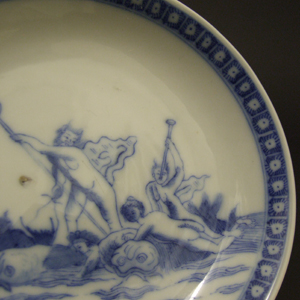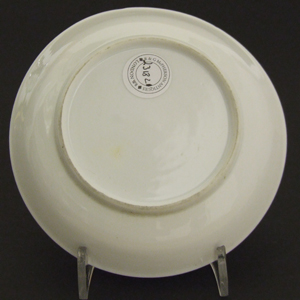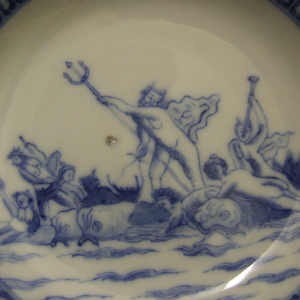
QIANLONG 1736 – 1795 Chinese Export Porcelain
A Chinese Export Soft-Paste Porcelain Blue and White Saucer with `Neptune`, Qianlong Period c.1750-1770.
SOLD
- Condition
- Perfect.
- Size
- Diameter : 11 cm (4 1/3 inches)
- Provenance
- N/A
- Stock number
- 23182
- References
- For a dish of this Chinese blue and white design dated to c.1740-1750 see : Chinese Porcelain in the Collection of the Rijksmuseum Amsterdam, The Ming and Qing Dynasties (Christiaan Jorg, Phillip Wilson, The Rijksmuseum, 1997) page 277, plate 321. Jorg states "The depiction of Neptune, the God of the Sea of classical mythology occurs in several varieties on Chine de commande from the 1740`s onwards. How well the design sold is illustrated by an order from 1778, when they sent a chocolate cup with this design as a model for similarly decorated plates. However, the Dutch merchants in Canton refused to have them made as `all that is European painting or figures costs twice as much as Chinese". For a blue and white porcelain bowl, cover and stand with this design dated to c.1765 see : Chinese Export Porcelain in the Reeves Center Collection at Washington and Lee University (Thomas V.Litzenburg Jr. Third Millennium Publishing London 2003. ISBN 1-903942-1-9-5) page 196, plate 195. A pair of plates of this design are illustrated in : Fine Chinese Export Porcelain, Christie`s London 11th and 12th of November 1985, lot 303.
Information
`Neptune` A Chinese Export Subject :
After an etching, which might contain some engraving, called `The Realm of Neptune` by Frederick Bloemaert (c.1610-c.1669) completed between 1650-1656, after a drawing by his father Abraham Bloemaert (1566–1651). This is a Baroque design is only executed in Blue and White on Chinese Porcelain, it occurs on fine grained porcelain and Chinese soft-paste porcelain. Both dinner services and tea services were produced, it appears that the teaware wares are soft-paste porcelain.
Chinese Soft-Paste Porcelain :
Christiaan Jorg States in : Chinese Porcelain in the Collection of the Rijksmuseum Amsterdam, The Ming and Qing Dynasties (Christiaan Jorg, Phillip Wilson, The Rijksmuseum, 1997) "Chinese soft-pate porcelain, which is different from European soft-paste, originated about 1700 and became popular in the second quarter of the 18th century as part of the export assortment. Unlike ordinary porcelain, it is not translucent and often has a creamy-white appearance. The glaze is often finely crackled as a result of a difference in cooling between the glaze and the body. The later is made of a white-firing clay, called huashi, `slippery stone`, the use of which is documented in the reports of 1712 and 1722 by the Jesuit Pere d`Entrecolles. As the clay was expensive, soft-paste pieces are usually small and thinly potted. They are also well-painted, as the body is particularly suitable for detailed drawing. Besides this `true` soft-paste, there are pieces with an ordinary porcelain body and a coating of `huashi` clay, which gives the same effect". Chinese soft-paste porcelain of the early 18th century appears to be confined to small objects used by Chinese scholars, small vases for a single flower, seal-paste boxes and other objects for the scholar`s desk. These pieces were special and more expensive than their hard-paste porcelain counterparts. By the mid-18th century soft-paste porcelain was used to a limited degree for export-ware, and few if any scholar`s objects were produced. It was used for, among other designs, pieces in the Meissen style but only for the blue and white porcelain. It seams curious to be copying European hard-paste porcelain with Chinese soft-paste porcelain, especially as it was more expensive to produce. This is especially odd as all the coloured Meissen porcelain was copied in hard-paste porcelain. Ironically many of the Meissen designs copied were themselves copies of Chinese designs. During the latter part of the 18th century soft-paste porcelain was used for larger pieces, vases, jars and other export wares, but even at this time it was normally reserved for the better quality painting and was painted with a good bright cobalt pigment.


